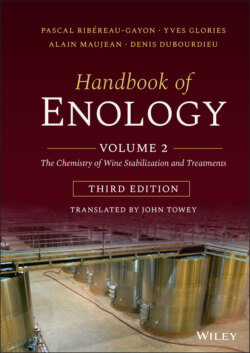Читать книгу Handbook of Enology, Volume 2 - Pascal Ribéreau-Gayon - Страница 61
2.5.2 Fatty Acid Ethyl Esters and Higher Alcohol Acetates
ОглавлениеEthyl esters of fatty acids, mainly ethyl hexanoate and octanoate, are produced by yeast during alcoholic fermentation. They are synthesized from forms of the acids activated by coenzyme A (HS‐CoA): acyl‐S‐CoA. Acetyl‐S‐CoA, from pyruvic acid, may be involved in a Claisen condensation with malonyl‐S‐CoA, producing a new acyl‐S‐CoA with two additional carbon atoms (Figure 2.8). Acetyl‐S‐CoA thus produces butanoyl‐S‐CoA, then hexanoyl‐S‐CoA, etc. Specific enzymes then catalyze the alcoholysis of acyl‐S‐CoA into ethyl esters of fatty acids. At the same time, coenzyme A is regenerated.
Fatty acid ethyl esters are formed by yeast, under anaerobic conditions, in quantities greater than those predicted by the mass action law. Consequently, they are hydrolyzed during aging and concentrations tend to decrease. Garofolo and Piracci (1994) determined the kinetic equations for the hydrolysis of esters of fatty acids in model media and in wines, at various pH values, over a period of 29 months according to their results shown in Table 2.5.
Fatty acid ethyl esters have aromas of wax and honey. They are present at total concentrations of a few milligrams per liter.
Acetate esters of higher alcohols (isoamyl acetate and phenylethyl acetate) should also be included among the fermentation esters. These compounds are present in moderate quantities, but have intense, rather unusual odors (banana, rose, and honey). They contribute to the aroma complexity of naturally neutral wines, but may mask some varietal aromas.
Among these acetate esters, isobutyl acetate (or 2‐methylpropyl acetate) plays a role in enhancing fruity aromas (Cameleyre et al., 2015). In contrast with most acetates of higher alcohols produced during alcoholic fermentation, this substituted acetate increases in concentration during tank/barrel aging and at the start of bottle aging. It is present in red wines in the form of its S enantiomer only, and its aroma is reminiscent of bananas. It is found at average concentrations of 72 μg/l, whereas its aroma perception threshold is about 1,100 μg/l. Nevertheless, despite its infra‐threshold concentration, it is known to contribute to black fruit, fresh fruit, and jammy notes in red wines.
The formation of all these esters is promoted when fermentation is slow (Bertrand, 1983; Dubois, 1993) and difficult, due to the absence of oxygen, low temperatures, and clarified must.
